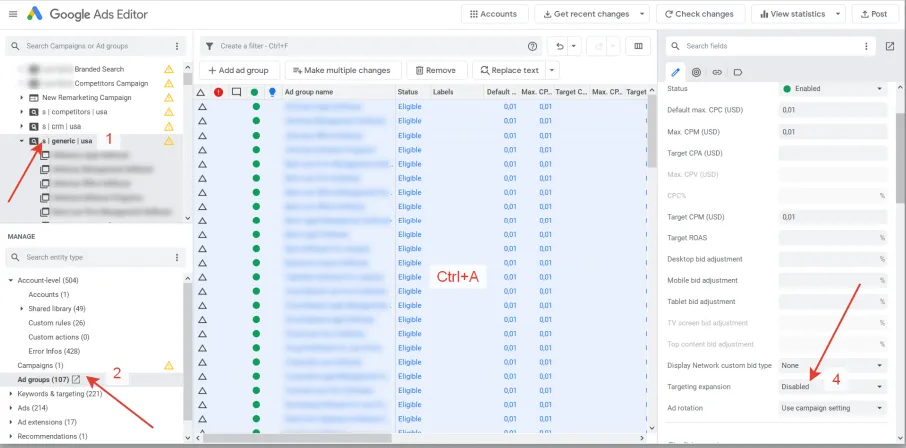7 Mistakes Wasting Your Advertising PPC Budget
Anna Saskevich
March 20, 2024

Are you struggling to achieve results from your PPC campaigns? You’re not alone. Many businesses face challenges with their pay-per-click advertising, ranging from tracking conversions to selecting the optimal bidding strategy. Based on broad expertise of working with SaaS and Tech companies, our PPC Manager, Anna Saskevich, has developed a comprehensive guide to address these common mistakes of wasting PPC budget and offer actionable solutions. Let’s delve into them below.
Mistake 1: Active Google Search Campaign Display Network Outreach
Google Display Network is a group of more than 2 million websites, videos, and apps where your ads can appear. Usually, Display Network gets the highest volume of the PPC budget as it has lower bids to get advertised on these placements. Google Display Network traffic quality is less relevant as it is more likely to rely on the user’s interests and search history instead of a particular search request.
Therefore, active search campaign Display Network outreach leads to:
- High volume of advertising budget spent on Display Network;
- Big amount of advertising budget spent on mobile devices as they prevail in generating traffic in Display Network;
- Irrelevant traffic and invalid clicks generated;
- Inaccurate statistics on campaign performance, leading to inability to scale the profitable segments.
Solution:
Turn Google Display Network outreach off to get more control over the target audience and increase lead quality.
How to check it on Google
Campaign > Settings > Networks > Include Display Network

How to check it on Microsoft Ads
Search Campaigns > Campaigns > Segment > Network

Mistake 2: Active Automated Bidding Strategy Within Sufficient Number of Conversions
Sometimes, an automated bidding strategy can show a good performance. However, to do so, you need to ensure the campaigns fulfill the following conditions:
- Proper conversion tracking using Google Ads conversion tracking tag;
- When you have the automated bidding strategy ON, the system automatically decides on the bid regulation and traffic distribution between segments (geo / gender / age / income level / devices). This significantly reduces the ability to control and optimize campaigns if you have not enough data for the system to learn.
- At least 30 conversions (50 ideally) in the account for the last 30 days. If the campaigns don’t reach this level individually, they might do at a portfolio level. If they still don’t, automated bidding strategy is not likely to be on your list of eligible bid strategies.
- Macro conversions set as primary campaign objectives, for example, completed transaction, demo booking or free trial sign up.
- Maximize Conversions with tCPA settings or Maximize Conversions with tROAS settings should be used, keeping realistic goals in mind. If your campaign has had an average CPA of $40 over the past six months, it’s not in your best interest to set a Target CPA of $20. It will limit Google right away in the auctions it can enter in and learn.
- We’d all like to shoot for a CPA of $1.00 or a ROAS of 900%. If you set your target too far off from where you are currently at (such as setting a target CPA of $1.00 while you are currently at a $100 CPA), then Google will be fumbling around trying to figure out how it can bid low enough to bring you in that $1.00 CPA.
Solution
Turn bidding strategy settings to Manual Bidding to control bids and optimize campaigns.
How to check it on Google and Microsoft Ads
Campaigns > Columns > Attributes > Bid strategy type

Mistake 3: Enable targeting/Audience expansion
Targeting expansion helps improve campaign performance by allowing the advertising system to reach a broader set of people. The system decides on its own what users are most relevant to the ones you specified in the detailed targeting section.
For example, if your campaign targets members with the skill “Data research,” Audience Expansion may expand your audience to members who list the skill “Data analysis” on their profile. You can’t specify skills or interests that the targeting should be expanded to. Therefore, you allocate your resources to the segments that might not generate any conversions.
Usually, CPC of such users is tangibly lower, however, their quality and intention might not be relevant for the business. You will never know what expanding the targeting really entails. The advertising system might both add and remove particular interests that you can’t control. This means that you get less control over the audience that sees your ads.
Solution
Turn Detailed Targeting off to improve lead quality and increase the number of conversions.
How to check it on Google Ads
Google Ads Editor > Recent Changes (Ctrl + Shift + T) > Campaign > Select Ad Groups (Ctrl + A) > Targeting expansion

How to check it on LinkedIn
Campaign > Click “…” > Manage > Who is your target audience? > Enable Audience Expansion

How to check it on Facebook
Campaign > Edit > Ad set > Audience > Detailed Targeting Expansion

Mistake 4: Targeting regions with a huge time difference within the same campaign
Targeting regions with a huge time difference within the same campaign may result in hitting the daily PPC budget at the time of audience inactivity. Say you have a campaign targeting Australian and European regions. Due to the time difference, the audience in Australia may hit the daily budget when the European audience is still inactive. As a result, you won’t have a chance to engage with the other audience, as you just won’t have the budget to take part in the auction.
Solution
Set separate campaigns for the regions located in similar time zones.
Mistake 5: Low bids and advertising PPC budget for a campaign
What advertising PPC budget should I invest in my paid acquisition strategy? This is probably one of the main concerns of any advertiser. There is no right answer: it usually depends on your goals and the aggressiveness of the campaign. That goes without saying that any advertising strategy should be cost-efficient. However, setting low bids on your ads might not even let them participate in the auction. If you bid too low prices, you risk your ads not being shown to the audience. As a result, you will get zero results.
Solution
Increase bids and advertising budget for the campaign.
How to decide on your advertising PPC budget
All campaigns need to fulfill an algorithmic learning period. To do so, they need to get a minimum number of impressions and clicks within the set PPC budget. One of the best practices is to set an advertising budget of 10x bid.
Mistake 6: Positive/Negative Bid Adjustments not set
Bid adjustments allow you to show your ads more or less frequently based on where, when, and how people search. It is important to clarify that bid adjustments work only if you are using a manual bid strategy.
For example, sometimes a click is worth more to you if it comes from a smartphone, at a certain time of day, or from a specific location. Bid adjustments are set by percentages. Say you’ve got a campaign that performs well on mobile devices, with a max CPC bid of $3. To show your ad to more customers on mobile devices, you increase your bid by 20% for searches on mobile devices, resulting in a final bid amount of $3.20.
Let’s look at some numbers:
- Starting bid: $3
- Mobile adjustment: $3 + ($3 x 20%) = $3.20
- Resulting bid for searches on mobile devices: $3.20
In another example, let’s say you have a $4 bid and would like to decrease it. To adjust it to $3.80, select Decrease by 20%. You can adjust bids by such parameters as device, location, ad scheduling, targeting methods, remarketing lists for search ads, and others.
Applying bid adjustments can reduce the amount of spend applied to under-performing settings and allow more PPC budget for what is working.
Solution
Analyze campaign performance and apply bid adjustments.
Mistake 7: Display Ads on TV Screen devices
The decision to show or not to show ads on TV Screens devices should depend on the specifics of the campaign, target audience, and advertiser’s goals. But usually, showing ads on these devices ends up costing more without giving back much in return. Here are the main reasons for that:
- It’s almost impossible to interact with ads on TV Screens, which makes tracking conversions difficult. If the campaign’s goal is user action (like a click or form completion), the effectiveness of ads on such devices will be very low.
- TV screens are often used for group viewing and children’s content, which complicates personalization and precise targeting.
- Users on TV Screens typically consume content passively and may be less responsive to advertising messages, especially if they are set on watching a specific video or program.
Turning off ads on TV Screens can save money that can be better spent on audiences that benefit more from it.
How to check it on Google
Insights & reports > When & where ads showed > Devices > TV screens

Aimers: Your Dedicated PPC Agency, Focused on Maximizing Your Ad Results
PPC marketing is best when it’s supported by the ongoing optimization efforts of both advertisers and PPC platforms. It requires a momentum-building series of tactics, adjusting for varying needs as your business grows and opens new business opportunities.
We are ready to share our expertise and industry-proven knowledge to generate more sales and drive brand awareness. Aimers handles all technical aspects of your campaigns: everything from strategy set up to campaign blending and troubleshooting.
Feel free to reach out to us if you require expert advice or assistance with your PPC and CRO activities.










.png)

